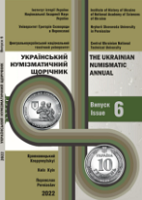ЗНАХІДКА ДОСЕВЕРНИХ РИМСЬКИХ ДЕНАРІЇВ В УКРАЇНІ, ВИЯВЛЕНА
A FIND OF PRE-SEVERAN ROMAN DENARII IN UKRAINE, DISCOVERED IN COMMERCE
Author(s): Robert D. LeonardSubject(s): Archaeology, Cultural history, Economic history, Ancient World
Published by: ДВНЗ Переяслав-Хмельницький державний педагогічний університет імені Григорія Сковороди
Keywords: denarii; Barbaricum; hoards; imitations;
Summary/Abstract: A group of Roman silver denarii minted prior to 194 A.D., and imitations of them, said to have been “Dug up in Ukraine,” appeared on the U.S. market in 2018. The goal of this paper is to discuss finds of Roman denarii in Ukraine briefly, to record four examples from this otherwise unpublished find, and to place these pieces in the context of currency in Ukraine in Late Antiquity. European Barbaricum – the areas lying outside the Roman Rhine, Danubian and British limites in the end of the Second Century A.D., to the Volga River in the east, including inland Ukraine but not including the Caucasus region and the Black Sea coast – used Roman silver denarii as currency, though probably merely by weight; over 500 denarii hoards from this area have been published, of which 95 were from Ukraine. There is evidence that these coins circulated for a century or more after they became obsolete in the Roman Empire itself, because of the heavy wear present on many examples. Though the size and location of the find which surfaced in 2018 – and whether it represents a hoard or single finds – cannot be determined, from the number seen (10 to 15), it is more likely to have been a hoard rather than a series of single finds. (Because of the manner in which the coins were sold, it was not possible to contact the seller readily; also, it was doubted that truthful information would be obtained anyhow, since the coins were presumably removed from Ukraine illegally.) Four examples preserved from it are published herein. These are: Denarius of Sabina, 128–136, very worn (2.62 g vs. normal weight of 3.0–3.2 g). Diademed bust right/Juno standing left (C 37, RIC II Hadrian 395A). Denarius of Antoninus Pius, 143/4, very worn (3.02 g) and apparently a fourrée, with base metal showing at top of head. Laureate head right/caduceus between two cornucopiae (RIC III, 107B). Struck copy (fourrée?) of denarius of Commodus, 190, very worn (1.82 g [sic!]). Laureate head right/Minerva advancing right (RIC III Commodus 222A). The surface is two-tone, as if plating is coming off, or dissolved silver from burial was redeposited. Struck copy (fourrée?) of denarius of Antoninus Pius – Commodus, 138–192, very worn (1.67 g [sic!]). Laureate head right/Ceres (?) standing left, pseudo? inscriptions. On this coin also it appears that silver plating is coming off, or dissolved silver from burial was redeposited. The presence of imitation denarii is not unexpected, because 15 of the recorded 95 denarii hoards found in Ukraine contained them. However, the very light weight of these two examples is unusual, and may indicate that a base metal core dissolved from acidic soils, leaving only a thick silver plating. Nearly all denarii hoards from European Barbaricum close with those of Commodus, 192 A. D.; from 148, the denarius maintained a standard of approximately 75–80% silver, but Septimius Severus reduced the standard to about 65% in 194, and to about 56% two years later. At this point most “Barbarians” refused to accept them as silver, and later denarii are nearly always absent from hoards. The same pattern can be seen in this group. These pieces offer further evidence that Roman denarii circulated (as silver, by weight) in Ukraine long after issue, some becoming very worn. Their dating is given as circa 200–400 A. D., though this is very approximate. No attempt is made here to assign them to a particular ethnic group.
Journal: Український Нумізматичний Щорічник
- Issue Year: 2022
- Issue No: 6
- Page Range: 124-130
- Page Count: 7
- Language: Ukrainian

